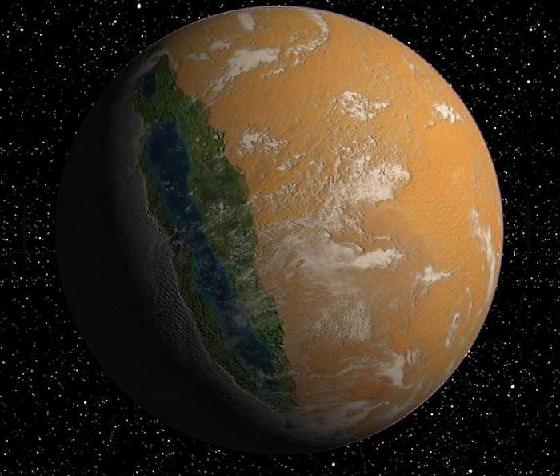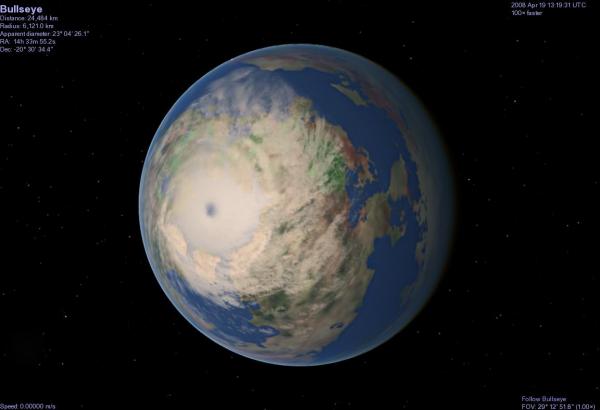BY LETTER
Vesperian Type Worlds
Tidally locked terrestrial worlds | |
 Image from Steve Bowers | |
| Twilight, a tidally locked terrestrial world | |
Worlds that orbit a star closely (generally less than 0.5 AU) tend to become tidally locked to the star in a relatively short amount of time. Since the habitable zone for red dwarfs (and for many orange dwarfs) falls inside this limit, many worlds located around these stars which might otherwise become temperate Gaian worlds are in fact tidally locked Vesperian worlds.
Worlds such as this can vary greatly, with remarkably different surface conditions resulting from having a permanent day and night side. However, a small but significant fraction of Vesperian worlds have developed biospheres that are stable for hundreds of millions, even billions of years. A particular set of circumstances must be met for a Vesperian world to become suitable for life, and the types of stars that they orbit are almost exclusively late K and early M-type stars. However, these worlds are so numerous that, in an overview of the Milky Way, these worlds might actually be at least as numerous as more standard Gaian Type worlds.
Many vesperian worlds have atmospheres which rotate constantly, bringing cool air from the frozen darkside to the hotter lit side and vice versa. This rotation is in part driven by the slow actual rotation of such a world; of course, any tidally-locked planet rotates once every orbit. The amount of rotation is therefore dependent on the orbital period. Planets very close to their star will have short years, and therefore more rapid atmospheric rotation; tidally-locked planets with longer orbits show much less atmospheric rotation, sometimes none at all.
 Image from Steve Bowers and The Astronomer | |
| Senrau, showing the atmospheric currents which transfers heat from one hemisphere to the other. | |
On other worlds which have thinner atmospheres of a few bar or less, the most hospitable location is at (or near) the terminator between the permanent light side and the permanent dark side. Here warm winds melt the ices of the dark side while cool winds refresh the searing heat of the permanent day side. Examples of this kind of world include Dante, Raphael and Twilight.
 Image from Steve Bowers | |
| Bullseye, a vesperian world with a semi-permanent substellar hurricane, caused by the interaction between solar heating and the planet's rotation. | |
In some planets the circulation of the atmosphere is more dramatic and irregular, and can sometimes form a permanent rotating hurricane storm at or near the substellar point. An example of such a world is Bullseye. The direction of the rotating storm may reverse periodically, and may be affected by the axial tilt of the world (usually minimal in a vesperian planet) or by the effects of other planets in the system.
Polyphemian subtype worlds | |
 Image from Steve Bowers | |
| Yanqiu, a Polyphemian subtype superterrestrial (a so-called 'eyeball world'). The warmest point on the surface of an icy, tidally locked world of this kind is more-or-less directly below the local sun at the sub-solar point. On Polyphemian worlds the ice in this region has melted, creating a patch of open ocean which might sustain life | |
Related Articles
Appears in Topics
Development Notes
Text by John M. Dollan and Steve Bowers
Initially published on 18 November 2008.
Initially published on 18 November 2008.






